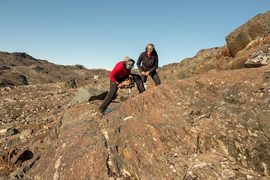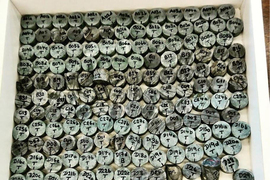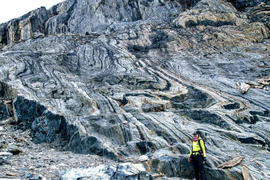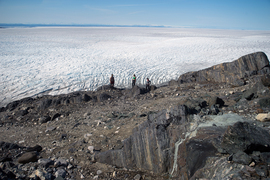Geologists at MIT and Oxford University have uncovered ancient rocks in Greenland that bear the oldest remnants of Earth’s early magnetic field.
The rocks appear to be exceptionally pristine, having preserved their properties for billions of years. The researchers determined that the rocks are about 3.7 billion years old and retain signatures of a magnetic field with a strength of at least 15 microtesla. The ancient field is similar in magnitude to the Earth’s magnetic field today.
The open-access findings, appearing today in the Journal of Geophysical Research, represent some of the earliest evidence of a magnetic field surrounding the Earth. The results potentially extend the age of the Earth’s magnetic field by hundreds of millions of years, and may shed light on the planet’s early conditions that helped life take hold.
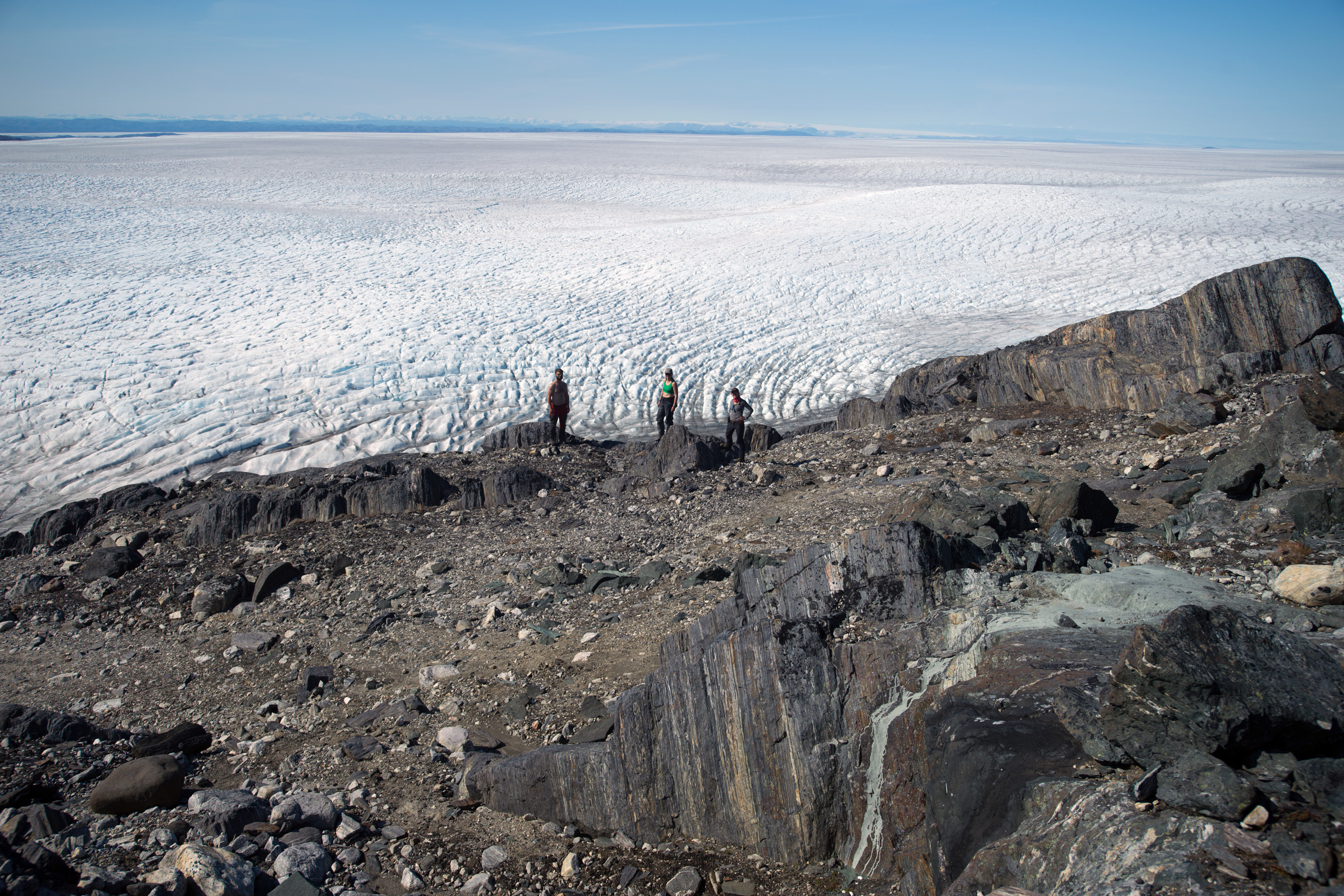
Credit: Claire Nichols
“The magnetic field is, in theory, one of the reasons we think Earth is really unique as a habitable planet,” says Claire Nichols, a former MIT postdoc who is now an associate professor of the geology of planetary processes at Oxford University. “It’s thought our magnetic field protects us from harmful radiation from space, and also helps us to have oceans and atmospheres that can be stable for long periods of time.”
Previous studies have shown evidence for a magnetic field on Earth that is at least 3.5 billion years old. The new study is extending the magnetic field’s lifetime by another 200 million years.
“That’s important because that’s the time when we think life was emerging,” says Benjamin Weiss, the Robert R. Shrock Professor of Planetary Sciences in MIT’s Department of Earth, Atmospheric and Planetary Sciences (EAPS). “If the Earth’s magnetic field was around a few hundred million years earlier, it could have played a critical role in making the planet habitable.”
Nichols and Weiss are co-authors of the new study, which also includes Craig Martin and Athena Eyster at MIT, Adam Maloof at Princeton University, and additional colleagues from institutions including Tufts University and the University of Colorado at Boulder.
A slow churn
Today, the Earth’s magnetic field is powered by its molten iron core, which slowly churns up electric currents in a self-generating “dynamo.” The resulting magnetic field extends out and around the planet like a protective bubble. Scientists suspect that, early in its evolution, the Earth was able to foster life, in part due to an early magnetic field that was strong enough to retain a life-sustaining atmosphere and simultaneously shield the planet from damaging solar radiation.
Exactly how early and robust this magnetic shield was is up for debate, though there has been evidence dating its existence to about 3.5 billion years ago.
“We wanted to see if we could extend this record back beyond 3.5 billion years and nail down how strong that early field was,” Nichols says.
In 2018, as a postdoc working in Weiss’ lab at the time, Nichols and her team set off on an expedition to the Isua Supracrustal Belt, a 20-mile stretch of exposed rock formations surrounded by towering ice sheets in the southwest of Greenland. There, scientists have discovered the oldest preserved rocks on Earth, which have been extensively studied in hopes of answering a slew of scientific questions about Earth’s ancient conditions.
For Nichols and Weiss, the objective was to find rocks that still held signatures of the Earth’s magnetic field when the rocks first formed. Rocks form through many millions of years, as grains of sediment and minerals accumulate and are progressively packed and buried under subsequent deposition over time. Any magnetic minerals such as iron-oxides that are in the deposits follow the pull of the Earth’s magnetic field as they form. This collective orientation, and the imprint of the magnetic field, are preserved in the rocks.
However, this preserved magnetic field can be scrambled and completely erased if the rocks subsequently undergo extreme thermal or aqueous events such as hydrothermal activity or plate tectonics that can pressurize and crush up these deposits. Determining the age of a magnetic field in ancient rocks has therefore been a highly contested area of study.
To get to rocks that were hopefully preserved and unaltered since their original deposition, the team sampled from rock formations in the Isua Supracrustal Belt, a remote location that was only accessible by helicopter.
“It’s about 150 kilometers away from the capital city, and you get helicoptered in, right up against the ice sheet,” Nichols says. “Here, you have the world’s oldest rocks essentially, surrounded by this dramatic expression of the ice age. It’s a really spectacular place.”
Dynamic history
The team returned to MIT with whole rock samples of banded iron formations — a rock type that appears as stripes of iron-rich and silica-rich rock. The iron-oxide minerals found in these rocks can act as tiny magnets that orient with any external magnetic field. Given their composition, the researchers suspect the rocks were originally formed in primordial oceans prior to the rise in atmospheric oxygen around 2.5 billion years ago.
“Back when there wasn’t oxygen in the atmosphere, iron didn’t oxidize so easily, so it was in solution in the oceans until it reached a critical concentration, when it precipitated out,” Nichols explains. “So, it’s basically a result of iron raining out of the oceans and depositing on the seafloor.”
“They’re very beautiful, weird rocks that don’t look like anything that forms on Earth today,” Weiss adds.
Previous studies had used uranium-lead dating to determine the age of the iron oxides in these rock samples. The ratio of uranium to lead (U-Pb) gives scientists an estimate of a rock’s age. This analysis found that some of the magnetized minerals were likely about 3.7 billion years old. The MIT team, in collaboration with researchers from Rensselaer Polytechnic Institute, showed in a paper published last year that the U-Pb age also dates the age of the magnetic record in these minerals.
The researchers then set out to determine whether the ancient rocks preserved magnetic field from that far back, and how strong that field might have been.
“The samples we think are best and have that very old signature, we then demagnetize in the lab, in steps. We apply a laboratory field that we know the strength of, and we remagnetize the rocks in steps, so you can compare the gradient of the demagnetization to the gradient of the lab magnetization. That gradient tells you how strong the ancient field was,” Nichols explains.
Through this careful process of remagnetization, the team concluded that the rocks likely harbored an ancient, 3.7-billion-year-old magnetic field, with a magnitude of at least 15 microtesla. Today, Earth’s magnetic field measures around 30 microtesla.
“It’s half the strength, but the same order of magnitude,” Nichols says. “The fact that it’s similar in strength as today’s field implies whatever is driving Earth’s magnetic field has not changed massively in power over billions of years.”
The team’s experiments also showed that the rocks retained the ancient field, despite having undergone two subsequent thermal events. Any extreme thermal event, such as a tectonic shake-up of the subsurface or hydrothermal eruptions, could potentially heat up and erase a rock’s magnetic field. But the team found that the iron in their samples likely oriented, then crystallized, 3.7 billion years ago, in some initial, extreme thermal event. Around 2.8 billion years ago, and then again at 1.5 billion years ago, the rocks may have been reheated, but not to the extreme temperatures that would have scrambled their magnetization.
“The rocks that the team has studied have experienced quite a bit during their long geological journey on our planet,” says Annique van der Boon, a planetary science researcher at the University of Oslo who was not involved in the study. “The authors have done a lot of work on constraining which geological events have affected the rocks at different times.”
“The team have taken their time to deliver a very thorough study of these complex rocks, which do not give up their secrets easily,” says Andy Biggin, professor of geomagnetism at the University of Liverpool, who did not contribute to the study. “These new results tell us that the Earth’s magnetic field was alive and well 3.7 billion years ago. Knowing it was there and strong contributes a significant boundary constraint on the early Earth’s environment.”
The results also raise questions about how the ancient Earth could have powered such a robust magnetic field. While today’s field is powered by crystallization of the solid iron inner core, it’s thought that the inner core had not yet formed so early in the planet’s evolution.
“It seems like evidence for whatever was generating a magnetic field back then was a different power source from what we have today,” Weiss says. “And we care about Earth because there’s life here, but it’s also a touchstone for understanding other terrestrial planets. It suggests planets throughout the galaxy probably have lots of ways of powering a magnetic field, which is important for the question of habitability elsewhere.”
This research was supported, in part, by the Simons Foundation.
